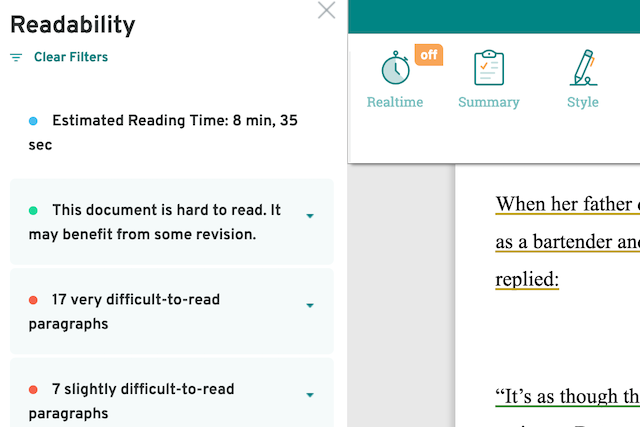
When you present big ideas it’s easy to use big words to amplify your meaning. But, before you write, think about the structure of your piece. And while you are writing, focus on clear writing.
You may be writing a web page that presents how technical aspects of a product work or a white paper on a political idea. However complex your subject matter, you don’t need big words or long, complicated sentences to explain it to your readers.
Clarity is one of the most important components of writing. Whether it’s a manuscript, a blog post, or a scientific paper, clarity is paramount. You could have the best mousetrap in the world. You could have compelling research to back it up. But if you’re not portraying that clearly, then no one’s going to engage with your work and they won’t buy that mousetrap.
What Is Clarity in Writing?
Clarity in writing comprises two components. First, how easy your writing is to understand. Second, whether your sentences are set in a way that makes them easy for your readers to interpret.
Think of your writing from the reader’s perspective. How easy is it for your reader to understand your writing? Our job is to get our meaning across clearly and effectively. If our writing is too complicated or too hard to read, then we’re not doing our job.
Your writing should always be clear and easy to understand. Not only that, it should also always be constructed with the reader’s understanding in mind. Different types of writing have very different audiences. What clarity means for an audience in an academic journal will be different than what clarity means for an audience looking for an athletic shoe.
Reading should always be full of rich words and sentence structures that add to a reader’s engagement. We think about the big picture, we think about the point that we’re trying to get across. We think about the points of our blog posts or if we’ve got every piece that we need to communicate in an email.
But when we think about clarity and when we think about making our writing focused, we want to start at the sentence level.
The Thingy Test
A few years ago, a medical friend of mine introduced me to neuroscience. In the spirit of learning, he sent me articles he thought I’d find useful. But, I had a big problem. I was completely unfamiliar with the terminology for brain parts. I would stop mid-sentence to look up a word.
By the time I found a definition, I had to start from the beginning of the sentence to get the meaning. And it wasn’t just one sentence. It was almost every sentence, sometimes with two or three words in the same sentence. Because I needed to stop so many times, I lost the meaning of the article.
I told him about my problem. He shared how he read when he started medical school. He read for the meaning first. Every time he encountered a term he didn’t understand, he read it as “thingy,” kept reading, and got the general gist of the article. Then he went back to look up the specific terms.
This might work for students getting to grips with highly complex topics, but most of the time you don’t want your readers to keep inserting “thingy” as they read your text.

Your Audience
Your audience determines the language of your text. My “thingy” problem was, as a layperson, I was trying to read text written for the medical community. If you are writing to a scientific body, your vocabulary may be more varied with specific terminology than when you write to a general audience.
When you want to explain how the technology works to improve a customer’s life, stress the benefits rather than your rock-star technology breakthrough. Customers want to know how the results of your technology will improve their life. Link to a separate article that explains your technological prowess in detail. There, you can develop your concept including technical language.
The same tactic applies to product descriptions. Future customers want to know how they will feel using your product. Stress tire safety and gorgeous garments before product composition.
Key your text to your desired audience. Vocabulary depth and sentence structure will guide your reader to take the desired action. You want to lead your reader to agree with your conclusion. Whether you are presenting a scientific concept or selling a product, write to your audience.
PRO TIP: For software as a service (SaaS) companies offering business to business (B2B) services, it is especially important to stress the benefits. Save the technology for a deep dive. Your sales team will love you. You’ve primed those potential customers.
Your Language
Your use of language controls readability. The basis for readability is knowing how to construct sentences and string them together into meaningful paragraphs. Short sentences are easier to read than long sentences.
If you find yourself writing long sentences, practice breaking them up into smaller sentences. You’ll improve readability for your audience.
Choose vivid verbs and plain words over generic verbs and inflated, multi-syllabic words. Even Google, infamous for unclear directions, explains how to use strong verbs for technical writing.
Eliminate to be verbs and change them to inclusive verbs for your reader. Switch the emphasis to engage your reader, using active voice instead of passive constructions. Here are some examples:
Weak Verb: The error occurs when clicking the Submit button.
Strong Verb: Clicking the Submit button triggers the error.
Weak Verb: This error message happens when ...
Strong Verb: The system generates this error message when ...
Weak Verb: We are very careful to ensure ...
Strong Verb: We carefully ensure ...
Writer David Leonhardt created a list of inflated words and their plain equivalents. Here are a few:
- Write “use,” not “utilize”
- Write “real” or “true,” not “veritable”
- Write “big” or “large,” not “sizable”
- Write “need,” not “require” or “requirement” or “necessitate” or “necessity”
- Write “must,” not “are required to”
- Write “base,” not “foundation”
- Write “book” or “magazine,” not “publication”
- Write “set up,” not “establish” or “install”
- Write “study” or “review,” not “investigate”
- Write “now,” not “currently” or “currently existing”
(Actually, that last one can usually be removed. If you write in the present tense, it is now. Unless there is a reason that readers might think it is some other time than now, leave it out.)
New writers, especially those who write to present a business, can fall into the trap of trying to appear knowledgeable by using big or over-inflated words. Be guided by what your audience needs instead of attempting to show your intelligence. Clarity is the clearest way to your reader.
When Only the Big Word Is Right
Not every word can be simplified. In scientific and technical writing, unfamiliar or specific technical words are your singular choice. For instance, if you are writing about climate change and the effect of human agriculture and industry you may use the word “anthropogenic” to describe those changes.
Maintain clarity by surrounding your big or technical term with smaller, plain-language words. These anthropogenic changes create new challenges. Stringing long words together into complex sentences make reading hard even for scientific colleagues.
Avoid Acronym Clutter
You may think that acronyms, initialisms, and abbreviations are short and easily understood. But, acronyms widely used in your industry may be unknown to your prospect. If you fill your content with what seems like a secret code, your prospect will not understand and is likely to leave, never to return.

To avoid readers baffled by your code and leaving, clearly introduce any acronym the first time you use it in your text. Introduce the full term followed by the acronym, initialism, or abbreviation in parenthesis or paired commas. For example:
- Customer Relationship Management (CRM) allows your business to follow and tag each prospect or customer in their journey with your business
- The break element , <br> or <br />, is one of several void elements, which are also known as self-closing elements
- Return on Investment (ROI) is a performance measure used to evaluate the efficiency of an investment or compare the efficiency of a number of different investments
When you follow up your introduction by using the acronym, your reader now knows your original reference.
PRO TIP: State the benefit of your acronym instead of using the acronym itself in your email subject line. Acronyms without a reference will hinder your open rate. Then, explain your acronym in the text body in your email message.
Check Your Readability
When you know what it is you want to say, it can be difficult to notice when your work is difficult to read. ProWritingAid’s Readability Report highlights difficult-to-read paragraphs so that you know where you need to make the changes I’ve demonstrated in this article.

You’ll see how long it would take the average reader to read your article, as well as a rundown of which paragraphs are easier or harder to read. Whilst this report won’t tell you what to do to improve readability, it will allow you to plan where you need to work on clarifying your writing.
The best way to find out how much ProWritingAid can do is to try it yourself!
Big Ideas, Clear Thoughts
Make complex topics clear and easy to understand for your reader. Precise language and clear syntax are keys to breaking down your thoughts and expressing them point by point. Readability helps your reader understand your big concept.
Use an editing tool like ProWritingAid to help with verb choices and readability enhancements to your text. Fine-tuning the small parts of your writing will help your readers understand your big idea.


